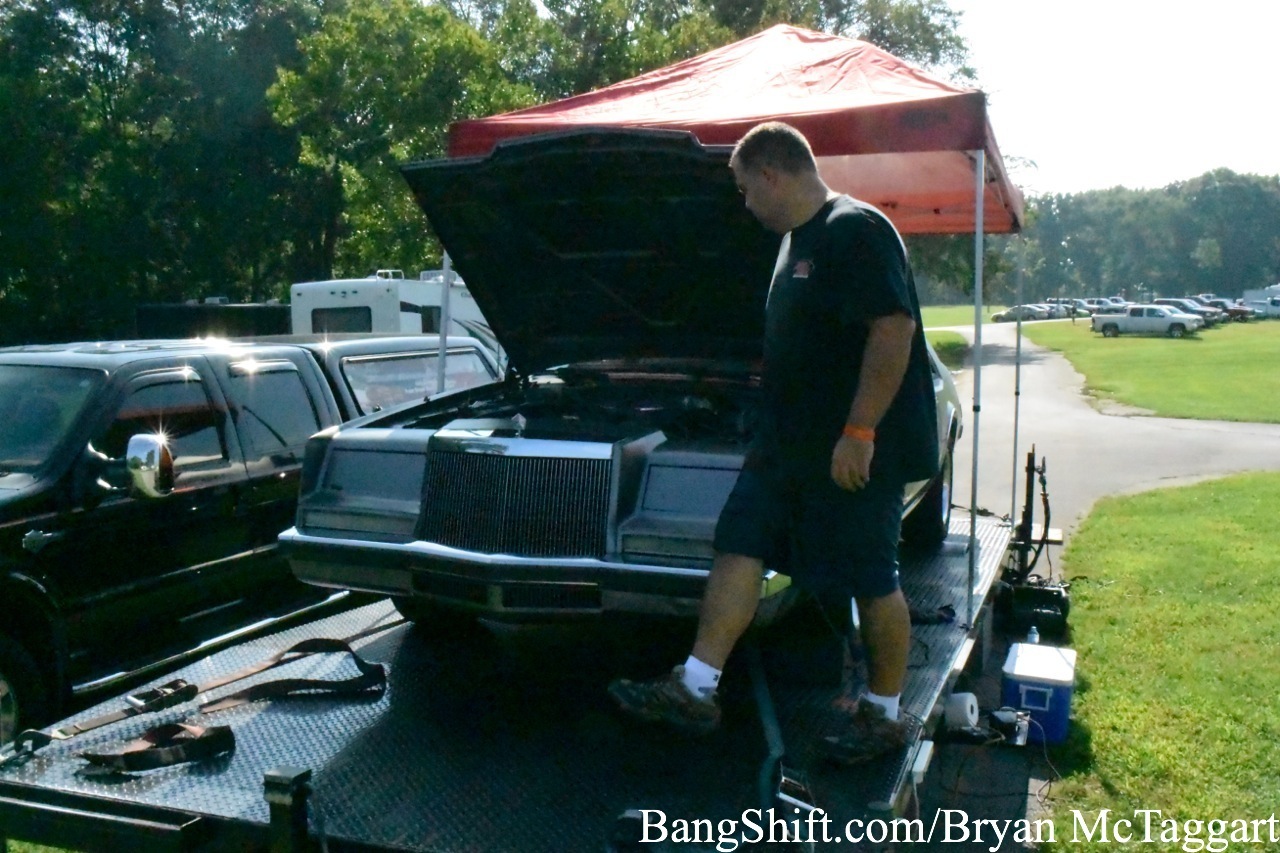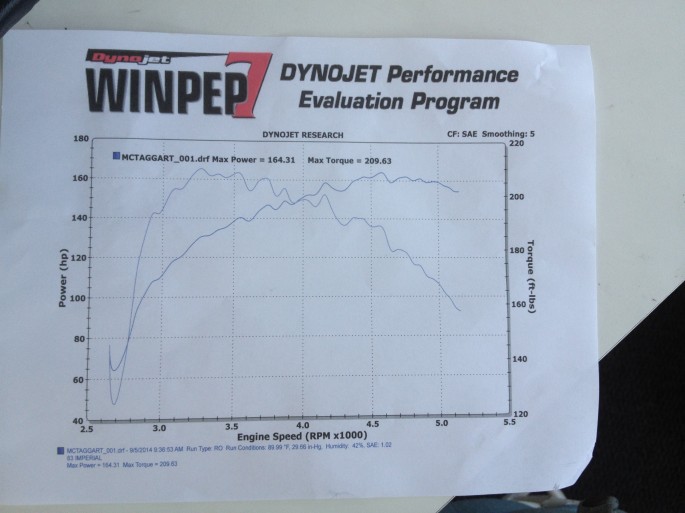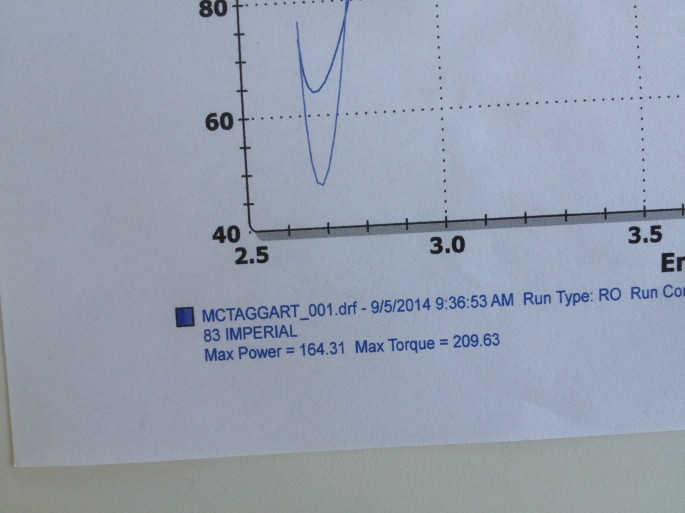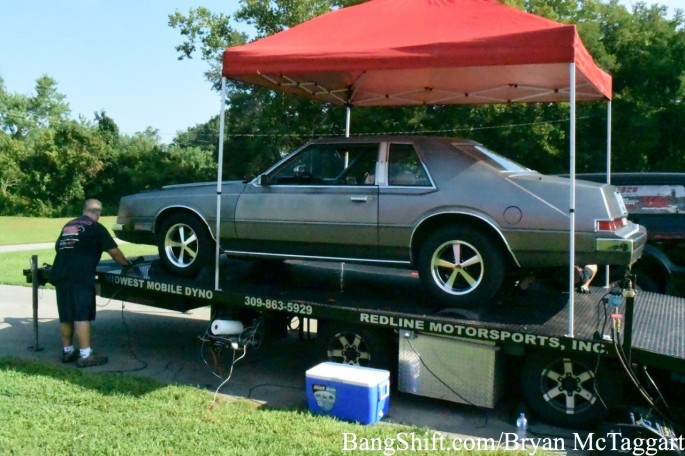It was destiny that a dyno was sitting at LS Fest. Ever since the 323ci motor was built, I have found myself wondering if the engine builder’s claim of 300hp at the crank was legit or not. The car moved well enough, but there wasn’t much else to go on for accuracy’s sake. Seeing that only one car had been on the dyno so far, and that it was early enough that there wasn’t a line, I slipped one of the operators a $20 and pulled up onto the great automotive lie detector. The car was strapped down and prepared, and I was behind the wheel. I was nervous: the Imperial’s dragstrip runs were very underwhelming and I wasn’t sure what to expect. Sure, the car is a heavy brick, but was that all I was fighting, or was the engine even close to the numbers claimed?
All I honestly wanted was a horsepower number north of 200 and a torque figure over 230. Using a 30% driveline loss as a standard, that would put me at 260hp and just under 300 ft/lb…nothing earth shattering but a realistic number. We decided to run the test in second gear, from 2500-5500. I started the car, cleared out the engine, and put it into gear. Once the straps were secured, I rolled into the gas to 2500, gave the thumbs-up to the guy holding the switch, and buried my foot in the pedal. From where I was sitting, once I crossed 4,000-ish RPM the engine fell over, then quickly rebounded and started climbing again. At 5,000-ish I went into valve float and abandoned further testing. The 323 was not pleased at this abuse.
Here’s the graphs:
I felt sick the second he told me. Comping for driveline loss, that’s 213 hp and 271 ft/lb torque. That’s seriously under what I was wanting to see. More disturbing is the chart, which shows a strange story between about 3K and 5K. At this point I’m not sure what the hell is going on yet. I’m sure the carb needs some attention, since it put out a lot of carbon smoke once I got out of the revs, but that’s probably not all. I’m not a wrench, but I think it’s time to do a leak down and see if one of the cylinders isn’t playing along. After that I’m on a learning curve to figure out why this car is about 30% down on power compared to where it should be.
Not everything with a project car goes right. Raven has been a daily driver since the engine was swapped in, and the engine did daily duty in the Mirada before that. I can’t bitch that much about an engine that is a damn sight better than what the original would be and has tolerated those stresses. But at least now I know where the car stands, and I know there’s room for improvement that can be done now.


























No worries. It’s always better to know what your car makes. I bet there are thousands of guys claiming horsepower number with nothing to back it up as proof. Just like the guys who claim their car “should” run high 11’s, mid 12’s, etc. Talk means nothing, you gotta go do it, and you did. Hats off! There is nothing wrong with being the weakest car on the dyno or the slowest car at the track that day, as long as your out there running your car and not sitting home running your mouth.
Staff Infection. I’m not sure painting it black will help but it might be worth a shot.
I wish either of my cars made 164hp AT THE CRANK. My Loyale only made 85 crank hp new (I estimate it’d down to about 60hp now) and my Miata only made 115hp
At least you know where you stand. I rook my 69 Fury to the dyno once. The 440 magnum I put in it was rated at 375 hp when new. With 95,000 hard mile I was hoping for 275 hp.I was pleasantly surprised with 352 with badly burnt valves
Bryan, its really a good start and now you know there is at least a tuning issue and have an idea where to begin.
The hesitation is likely from either signal to the secondaries or delivery. A carb rebuild and/or recalibration is in order. I’d also look at initial timing and full advance. The motor might not be a thundering Hemi, but likely should be putting out more than it is. I’m not sure a leakdown test is in order just yet (doesn’t hurt). A simple compression test will tell you if it is basically healthy.
You should not be floating valves at 5,000rpm if the right springs were used. I’d check on what springs are in there and compare them to your cam card. Its likely something doesn’t match up. The only thing that could be a problem there is if the engine has been overly hot and the springs were socked. All springs lose pressure, but it shouldn’t be so much that float is noticeable at 5k unless the engine is flat worn out.
You might look at fuel delivery to the carb as well. It might be that pressure is low or high and demand from the motor and vacuum signal are not being met with the proper volume of fuel when its needed. I’ve not committed your combo to memory so I don’t know if you have a aftermarket mechanical, electrical, or what. I’ve seen where folks have had a restriction in the line that would act as yours did because a steady volume and pressure were not arriving at the carb.
It might sound like a lot, but its really not. Now if I would only spend more time getting the fine touches done on mine…….. Carb’s too small so it is going away eventually anyway. Still, tip in is hit and miss. Getting too much fuel just past off-idle/cruise then it leans out some. Likely needs the next step metering rod on the primaries. I LOVE Carbs and Distributors…..!!! It might require screwdrivers and wrenches, but I got sick of laptops, datalogging, and fishing for the right numbers to plug into the all too elusive tables.
I agree with all that Doug mentioned above. Those are the right places to look first.